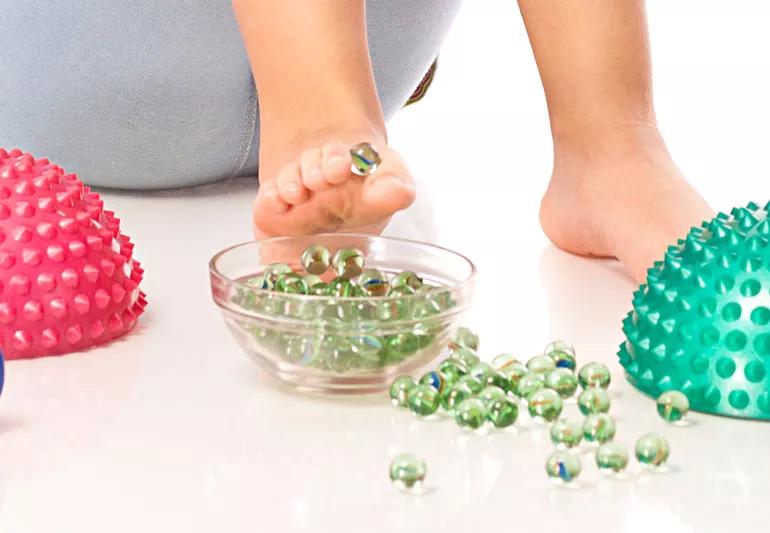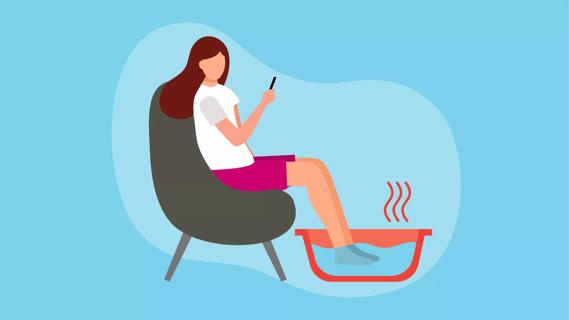How to safely stay active if you have flat feet

When it comes to your feet, you want to do everything you can to keep them healthy and in top shape. This is especially important for people who have flat feet, a condition where one or both feet have no arch when standing.
Advertisement
Cleveland Clinic is a non-profit academic medical center. Advertising on our site helps support our mission. We do not endorse non-Cleveland Clinic products or services. Policy
While most people with flat feet don’t have significant health issues, the condition still requires extra care and attention, particularly for those who’re active and on their feet a lot. Whether it’s strengthening flat feet and the muscles and tendons affected or knowing what to avoid, awareness is key.
For more on strengthening exercises for flat feet, as well as what not to do for flat feet, we spoke with physical therapist Michael Bogden, PT, DPT.
It’s common to hear flat feet used interchangeably with the term “fallen arches.” The only real difference, according to Dr. Bogden, is when the condition happens. “Flat feet are congenital, a condition you’re born with,” he says, “while fallen arches usually refer to a structural change in the foot that occurred over time.”
Since flat feet and fallen arches are similar, the approach to treating and exercising them is often the same.
In short, yes, exercise is good for flat feet. Notes Dr. Bogden, “As long as you’re not having pain, and progress increases in activities or exercise in moderation, there’s no reason to limit yourself.”
He adds that exercise is the best thing you can do for flat feet, as this creates a lot of muscular support to make up for the structural instability that’s not there. “The bones and ligaments don’t provide the amount of structural support you would like them to,” Dr. Bogden says. “It’s the same as strengthening your rotator cuff when you have instability in your shoulder.”
Advertisement
It’s not unusual for a person with flat feet to be wary of walking around barefoot or going without some sort of support. But it’s essential to get some sort of exercise. “If you’re constantly using support, those muscles won’t get the necessary work they need to be strong, leading to weakness, which can worsen instability,” explains Dr. Bogden.
Again, as long as there’s no pain and exercises are progressed in moderation to assess how well your feet are tolerating the exercise, he says it’s OK to be as active as you feel comfortable.
While there are plenty of great strengthening exercises for flat feet, it’s important to consult with your healthcare provider, podiatrist or physical therapist before starting. “Since there’s such a wide spectrum of conditions for flat feet, it’s important to understand where you are on that spectrum,” says Dr. Bogden.
“Think of it like this: There’s a range of different doses for any medication, so you need to speak with your doctor to determine where the best place to start is,” he continues. “It’s the same thing here. Should you start with non-weight-bearing exercises or can you add weight-bearing and dynamic movement to the exercises?”
Here are some of the exercises that those with flat feet should consider.
Also known as “foot doming,” arch lifts involve keeping your feet flat on the floor and raising the arch of your foot as much as you can, rolling the weight of your foot to the outside while keeping your heel and toes on the ground. You can perform the exercise either standing or sitting.
“It strengthens the intrinsic muscles of the foot and research shows that it helps other conditions like plantar fasciitis,” says Dr. Bogden.
Another exercise that strengthens the intrinsic (deep) muscles in your feet involves using your toes to pick up marbles. Place 10 to 20 marbles on the floor next to a bowl. While seated, use your toes to grab each marble and place it in the bowl. Dr. Bogden adds that picking up a towel with your toes can give you a similar workout.
An easy exercise, begin with feet flat on the floor and raise your heels, putting the weight on the balls of your feet. Hold the position for a few seconds and slowly lower yourself down.
Walking across the room on your heels with your toes in the air can strengthen muscles in your ankles and feet. Repeating the exercise on your toes with your heels in the air (essentially walking tiptoe) can do the same.
Typically, stretching is something that is part of a regular exercise routine, keeping muscles loose. But in the case of flat feet, Dr. Bogden says stretching is a bad idea. “Because there’s already some instability, stretching can lengthen your muscle tissue and cause further instability.”
Advertisement
Instead, he says massaging should be part of your regimen to help keep those foot muscles from getting too tight. “We want to treat those tight spots in the muscles but not in a way that’s going to make them longer or less able to provide support.”
Some of those options include:
The key, Dr. Bogden says, is to treat not only your foot, but also your calf and even your spine because of the way certain muscles — like the gastrocnemius and soleus muscles, the large muscles in the back of your lower leg — connect your calf to your foot. It’s a holistic approach that keeps your lower body both strong and without tightness to alleviate issues caused by flat feet.
It’s definitely possible to perform aerobic exercises with flat feet, says Dr. Bogden, as long as you start easy and work your way up. “Start with exercises that will reduce weight-bearing on your feet, like biking, swimming or rowing.”
As you grow more comfortable and your feet adapt to the activities, he recommends trying to progress to exercises that may have more weight-bearing aspects, like an elliptical machine.
Advertisement
When it comes to any sort of walking program, Dr. Bogden says it’s OK to start right away, but to start with short distances first. “Even if you have flat feet, you’re probably walking every day, so as long as you’re not doing it for significantly longer durations than you commonly do daily, you’re OK.”
Build up to those longer distances at a slow but steady pace. “It’s no different than those couch-to-5K running programs,” he says. “You slowly increase the distance for a week or two, cut back for a recovery week, then proceed to increase your distance again.”
But the easiest place to start is right at home. “You can start walking around your house barefoot, see if your feet can tolerate those short distances, and start building up that strength and endurance necessary to increase your activities further,” he advises.
As with where to start, which exercises you should avoid all depends on where you fall on the spectrum in terms of the condition and strength of your feet. “Nothing has to be avoided if you’ve worked your way up to it and you haven’t had pain or other undesirable symptoms like severe tightness,” says Dr. Bogden.
Still, it’s best to be cautious with exercises that can get aggressive with jumping and add more stress on your feet. “With workouts like playing basketball or distance running, you want to be careful,” Dr. Bogden notes. “It’s not that they should be avoided, it’s just that you have to give your body time to adapt to that much loading on the muscles.”
Advertisement
For instance, if your body’s not ready for you to run a 10K or go all-out in a game of pickup basketball, those muscles in your feet, ankles and lower legs can get severely overloaded compared to what they’re used to, causing tightness and injury.
Dr. Bogden adds, “Any increase in activity that is dramatically more than usual will put someone at risk for things like excessive soreness, muscle tightness, or injury.”
While it’s always best to talk to your healthcare provider or physical therapist about what equipment will work best for you, Dr. Bogden says there are a few things that should help those with flat feet exercise safely.
“Be sure that your shoe comes with a toe box that allows your toes to splay or spread,” he recommends. Having the toe box of the shoe too narrow can change how your foot contacts the ground and supports your body, which may lead to other injuries.
Feel free to try over-the-counter arch supports, too, but keep an important question in mind when using them: Do you feel better when you’re using them?
“People sometimes want to force their body into using these tools, but if it’s supporting your muscles and putting your foot into a good position, you should feel better when using them, not worse,” Dr. Bogden says.
If you feel worse after giving them a fair assessment ranging from a few hours to a couple of days, stop using them and consult your doctor or physical therapist.
The important thing is that you provide your feet with some form of exercise and don’t fully rely on those supports all the time. “If you always support your muscles with orthotics, those muscles don’t get the workout they need, so they’ll have a limited ability to be strong and help provide the much-needed support your foot needs to make up for the lack of support commonly provided by the bones and ligaments,” he explains.
“Whether it’s aerobic exercises or even just walking in your house barefoot, like all muscles, be sure your feet are getting some exercise,” Dr. Bogden says. “Just give your body extra time to adapt to the added challenge those foot muscles have, and understand that some tightness will be part of the process. And that can be helped with a variety of approaches to help loosen up tight muscles, such as massage from a therapist or self-massage options.”
Learn more about our editorial process.
Advertisement

Try seated and standing exercises to help lengthen and strengthen the muscles that support your plantar fascia

Home remedies are unlikely to cure your contagious foot fungus — and they might even make it worse

Cramps can creep up if your shoes are too tight, you’re dehydrated or you have poor circulation

If soaking your feet, disinfecting your shoes and making lifestyle changes don’t do the job, it’s time to talk to a doctor

Genetics, hormones, medications and stress are just a few reasons your feet could be extra funky

Try stretching, massage, elevation and a supportive pair of shoes to help relieve foot aches and pains

Footwear that offers cushioning plus heel and arch support can help you relieve and manage symptoms

Except in certain medical scenarios, foot health experts rarely recommend foot soaks

The best parenting style balances enforcing rules and showing plenty of love

Tips include cutting back on sugar, focusing on exercise and managing stress

It can be harder to let go when you’ve invested time, energy and emotions — but it might be the healthier choice long term